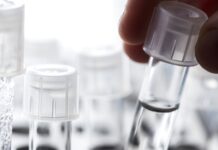1. What is Dyshidrotic Eczema?
Dyshidrotic eczema is a kind of eczema that affects both the hands and the feet, with the hands being more frequent. It primarily affects young individuals and the elderly. The majority of patients with this kind of eczema have a history of allergies.
2. What is the appearance of Dyshidrotic Eczema?
Small fluid-filled vesicles occur along the sides of the fingers, palms of the hands, or the bottoms of the feet in the early stages of this kind of eczema. The vesicles may burst, resulting in weeping crusts that might take many weeks to cure. As the vesicles heal, they may leave rings that mark the spot where they used to be. The skin underneath the vesicles is usually unaffected.
A frequent consequence is a bacterial infection of open vesicles. Cellulitis, an infection of the soft tissues of the hands and feet, can develop as a result of this spreading in the tissues. The infection has the potential to spread to nearby lymph nodes. In rare cases, the infection can spread to the bloodstream, resulting in septicaemia (a life-threatening bacterial infection). Nails may grow thick, pitted, discoloured, and ridged as a result of the condition.
3. The Myth of Dyshidrotic Eczema
Excessive sweating of the hands was considered to be the cause of this type of eczema, thus it was given that name. It is now known that the fluid that collects in the vesicles is serum rather than perspiration. When the skin becomes irritated, it is felt that the serum has accumulated between the outer layers of the skin.
4. What causes Dyshidrotic Eczema?
Why people get Dyshidrotic eczema is a mystery to researchers. However, a number of factors have been identified as being linked to its growth. Its prevalence follows a seasonal trend, with warm temperatures being more prevalent. After being exposed to extremely hot temperatures, some people get Dyshidrotic eczema.
People with a history of contact irritant dermatitis are more likely to develop the disease. It’s particularly connected with specific occupations. People who have to wash their hands frequently, such as cooks, nurses, and dentists, are more likely to get this kind of eczema. Irritators like solvents, detergents, and soap exacerbate dyshidrotic eczema.
5. How to treat Dyshidrotic Eczema
The best way is to figure out which irritant is causing it to grow and avoid using it. Aside from that, therapy is symptomatic. For the severe itching that usually comes with this disease, your doctor may prescribe an anti-itch medicine. To aid in the drying of blisters, weak potassium permanganate or aluminum acetate might be utilized. In the acute phases of the disease, steroid ointments may be used to aid in the healing process. For a limited duration, oral steroids may be administered in severe instances.
It’s also crucial to keep the skin hydrated to avoid the dryness and severe cracking that Dyshidrotic eczema may cause. It is recommended that you apply a heavy moisturizer.
The Basics Of Eczema
“Eczema” is defined as “an inflammatory condition of the skin marked by redness, itching, and leaking vesicular lesions that become scaly, crusty, or hardened,” according to Merriam-Webster. The term “ekzein” derives from a Greek word that meaning “to erupt or boil over.” Eczema is also known as “dermatitis,” which comes from the Greek word “derma,” which means “skin.” Both of these words are sometimes used interchangeably. These two words encompass a wide range of diseases, but they all revolve around symptoms like irritated and itchy skin that can turn into a rash if touched.
Despite everything that is known about the disease, the actual etiology is unknown. As a result, the treatment is likewise a mystery. Eczema, on the other hand, maybe controlled with the right therapy. The key to properly dealing with eczema is identifying and avoiding the items that aggravate it, as well as following a dermatologist’s treatment recommendations.
If eczema is suspected, a dermatologist should be seen, especially because not all cases of dry skin are eczema. Cold, windy weather, as well as extended exposure to direct sunlight, can create dry, itchy skin that is not related to eczema. It’s merely that skin loses moisture fast under these settings, necessitating hydration. Try a natural skincare product and observe whether the issue improves with only dry skincare. It’s ideal to use a lanolin-based skin lotion that contains Vitamins A, D, and E, as well as Aloe Vera. If the dryness persists, you should see a dermatologist since eczema might be the cause.
Eczema affects both men and women, and it affects people of all ethnicities and ages. Seborrheic dermatitis and atopic dermatitis are the two most common types. Contact with irritants such as chemicals, cleaning agents, or fragrances causes seborrheic dermatitis. Allergies to a specific substance, such as nickel, chromium, or rubber, trigger atopic dermatitis, which is considered to be genetic in families with a history of allergies. Atopic dermatitis is the most prevalent kind of dermatitis. Seborrheic dermatitis affects just around 3% of the overall population.
Types
There are, however, several types of illness. Dyshidrotic, nummular, and eczematous are some of the additional disorders associated with the eczema group.
Dyshidrotic Eczema
Dyshidrotic eczema, commonly known as hand eczema, often affects the hands, but it can also affect the soles of the feet, the sides of the toes, and the tips of the fingers. It causes tiny, transparent blisters to form on the skin, which create a burning or itchy feeling. A symmetrical pattern is common when a rash appears. People who live in hotter regions have an increased chance of contracting the condition, but it is not caused by perspiration, contrary to common perception. The actual etiology is unknown, however, there is some indication that it is linked to skin contact with nickel-containing metals or jewelry.
Nummular Eczema
Nummular eczema isn’t allergic or inherited. The lower leg is the most affected. Due to the circular areas that develop, which are brown, red, or pink and have a dry, cracked surface, it’s also known as “discoid” dermatitis. The areas might become rough, blistering, or crusty, and they can become exceedingly irritating. It can linger for days, weeks, or even months before dissipating on its own.
Eczema Herpeticum
When someone with eczema comes into touch with someone who has the herpes simplex virus, dermatitis herpeticum can develop. The herpes simplex virus is usually associated with cold sores around the mouth, but when it comes into touch with pre-existing eczema, it can spread throughout the whole surface of the skin, utilizing eczema as a basis. Small skin blisters filled with yellow pus occur on top of the normal eczema rash, indicating this condition. The individual may also develop a high fever and flu-like symptoms. Eczema herpticum, unlike any other type of eczema, can be deadly, invading the eyes, lungs, kidneys, and other organs. Medical help is required.
Eczema is the world’s most prevalent skin ailment, and its prevalence has risen in recent decades. The ability to recognize it is the first and most important step. Then see a dermatologist for advice on the best course of action. Make sure the treatment you’re getting doesn’t contain any perfumes or chemicals that might irritate your skin. A lanolin-based lotion for dry skin that employs natural components like Aloe Vera and vitamins A, D, and E as a therapy or in conjunction with it will assist to provide relief.

What Are the Causes of Dyshidrotic Eczema?
Eczema and its various distinct variants, such as Dyshidrotic Eczema, are now linked to a variety of factors. Dyshidrosis was once considered to be caused by excessive sweating, although many current patients do not have a history of aberrant sweat patterns. Excessive sweating is no longer thought to be a primary cause of the disease, but it has been shown to irritate vesicles on the feet or hands, resulting in vesicle eruption. Stress or trauma is a frequent component in the majority of skin diseases. Stress and mental agony may appear in a variety of ways, including on the top layer of one’s skin. Additional stress can easily worsen the disease, leading to more severe symptoms.
Evidence suggests that Dyshidrotic Eczema is the result of a hereditary susceptibility based on a patient’s DNA. Certain metals, such as cobalt and nickel, as well as other chemicals, have been linked to the onset of severe dyshidrosis pompholyx in individuals. Faux jewelry, as well as work and leisure settings, frequently include these chemicals. Many individuals with dyshidrotic eczema have reported that violent outbreaks of the illness appear after their skin has been exposed to chlorinated pool water, with fluoride-filled municipal water being another irritant. Certain antibacterial soaps and perfumes have been linked to eczema flare-ups.
Fungal infections, such as tinea pedis, or “Athletes Foot,” are frequently associated with dyshidrotic eczema. Certain garments, such as nylon, wool, and other synthetic textiles, help to dampen your skin even more and should be avoided, as they might trigger or aggravate the sickness or generate cases of it. Skin tapes, bandages, and plasters should all be avoided due to the skin’s desire to “breathe.” Many people with dyshidrotic eczema report that the balsam of Peru is an irritant.
Smoking and excessive coffee use, in particular, have been proven to exacerbate the severity of the disease. With all of these factors at play, it’s impossible to miss the most obvious: inheritance. If your family has a history of eczema or atopic dermatitis, your chances of developing dyshidrotic eczema are substantially increased.
Stress, Inheritance/DNA predisposition are the main causes with other causes:
• Contact with metals such as nickel and cobalt, as well as other compounds
• Infections caused by fungi, such as tinea pedis
• Typical skin irritants
Treatment for Dyshidrotic Eczema: What You Can Do to Help Yourself
Dyshidrosis sometimes referred to as Dyshidrotic Eczema, is a persistent skin disorder marked by tiny blisters on the hands and feet. Dyshidrosis gets its name from the term “dyshidrotic,” which means “bad sweating,” which was thought to be the reason. Pompholyx is another name for it, which means “bubble” in Greek and refers to skin blisters. PMpholx can also refer to hand dyshidrosis in rare circumstances. Although this skin ailment is not infectious, it can cause tremendous tension and agony in those who suffer from it. Not to mention the fact that the disease is unattractive, which can lead to social anxiety and low self-esteem.
Dyshidrosis has yet to be definitively diagnosed. It’s frequently linked to other skin conditions including atopic dermatitis, contact dermatitis, bacterial infection, or stress. However, there are numerous possible causes for the disease to worsen:
– Nickel sensitivity might be a major contributor to dyshidrosis. Dyshidrosis patients who were given a reduced nickel diet had fewer flare-ups, according to tests.
– Contact with allergens might be the source of the problem.
– Toxic metals including copper, mercury, and nickel
– Aspirin use, oral contraceptives, cigarette smoking, and implanted metals are all probable causes.
Unfortunately, because dyshidrosis is a form of eczema, the most frequent therapy for it is topical steroids, which can have long-term side effects including skin thinning. Hydrogen Peroxide (35 percent strength) and potassium permanganate solution are two more options. Both of these can help to some extent, however, they come with a lot of burning and itching as a side effect.
As a result, it is suggested that in order to treat Dyshidrosis, one must return to the basics, which include strengthening the immune system and removing toxins from the body.
After you’ve taken care of the fundamentals, consider the following home treatments for Dyshidrosis relief:
– Apply emollients on a regular basis to avoid cracking and irritation. Because petroleum jelly does not penetrate into the skin, it should be avoided.
– Soak in a bath of sea salts or Epson salts. Soaking in white vinegar provided comfort for some.
– Stay away from strong shampoos and body washes. Use a mild bath oil instead. When washing your hair or swimming, remember to use gloves if you’re experiencing flare-ups.
– If you’re allergic to nickel, stay away from it. Nickel may be found in a variety of foods, as well as jewelry, computer keyboards, dental fillings, and bras.
– Avoid stressful circumstances or learn how to cope with them.
– Try not to scrape. I understand that it is easier said than done. To protect your hands, try wearing unbleached cotton gloves.
– Infusing plantain (Plantago major) with olive or other oil might be relaxing.
– While reading newspapers, books, and periodicals, put on cotton gloves. The lead in the ink might cause irritation.
– Alcohol-based hand sanitizers should be avoided. Alcohol is drying and might exacerbate the problem.





